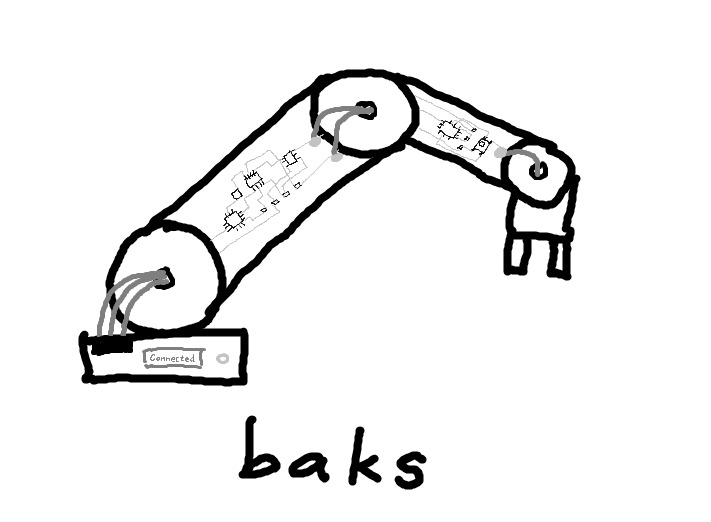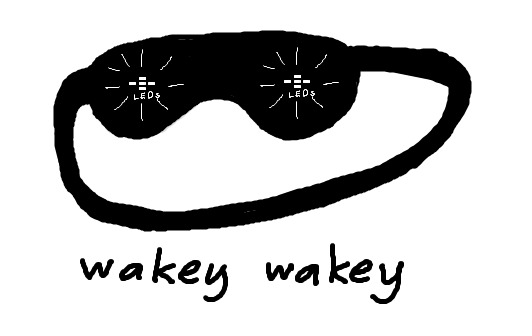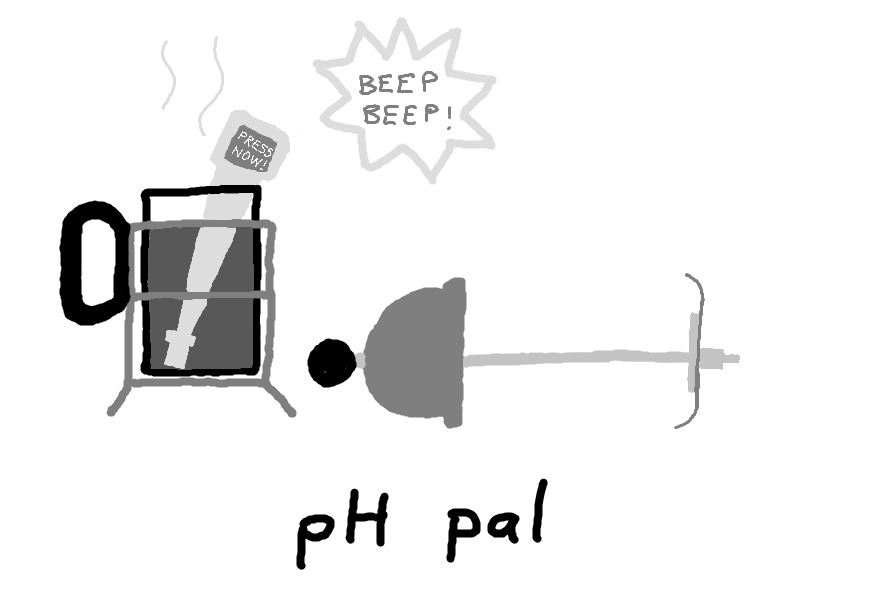Final Project 
I have three ideas for a final project: A robot arm, a wake-up mask and a digital stirring stick that tells me when to press down with the French press to get a perfect brew. Let's go through them one by one, with illustrations made in MS Paint.
Idea 1: baks the robot arm

I want to make a robot arm. I realize that this is not a particularly original idea, but I just dig robot arms. I want to call it baks, which is the noun version of the Icelandic verb baksa, which means to 'busy oneself' or to 'be industrious', usually in the context of toddlers playing energetically outside, digging and dragging logs about and throwing rocks.
Here's a video where I describe the final project to Neil Gershenfeld during random review.
A bit of history
I backed the original uArm on Kickstarter and enjoyed using it until I accidentally connected the power supply directly to the Arduino instead to the uArm Shield. The plan was to have it fry doughnuts and frost them but the arm ended up getting fried instead. The software part also intimidated me.
In one of the courses in my Mechanical Engineering degree, the task was to pick up a wine glass and give the professor a sip. The rationale behind it was to think about solutions for people with Parkinson's disease. My group put a lot of work into making a robot arm with a soft 3D printed hand that I found on Thingiverse. We converted an old theatre light (if you find one, they're a treasure trove, this one had 13 stepper motors). I designed and 3D printed all the custom components and the arm worked.
But then I wanted an arm that can do more than one thing. When Fab Lab Ísafjörður needed something to impress the President of Iceland and the First Lady, Karítas at Fab Lab Sauðárkrókur was kind enough to loan us a Niryo One, a 3D printed educational robot arm based on steppers and Dynamixel servos. I programmed the robot to hand the First Lady a laser cut business card, and had great fun experimenting with the robot. Then I fried one of its servo motors when a cable connector got stuck and the robot kept trying to move to its intended position. I managed to swap out the motor, but I thought that surely there's an improvement to be made here.
Since educational robot arms seem to be mostly used to move colored cubes around, I think it's OK to scale them down and simplify them to make them less expensive and more accessible. I'd like to base my arm on brushless motors without any gearing, and use springs to balance it, just like the Anglepoise lamp. Then it's nimble and can't damage anything. It won't be able to lift much, but that's OK! I only want it to lift a paint brush or a colored cube.
Outline of the idea
Since I have a history of frying robot arms, I have a few personal design goals for my arm.
- Cannot hurt itself or the user
- Easily programmed by moving the arm and saving keypoints and paths
- Small
- Cheap
- Precise enough to paint candles
The last point warrants a little explanation. Kertahúsið in Ísafjörður manufacture candles in the shape of known buildings in the town and now around the country. It was started by a couple who were on parental leave but the money wasn't enough to live on. So they came to Þórarinn at Fab Lab Ísafjörður and he helped them mold and cast the first candle houses. He was able to do this because of his experience at the Fab Academy. This was only last year, but their product offering now counts dozens of different designs. Every time they make a new design, the model is 3D printed here at Fab Lab Ísafjörður and Sædís and Gunnar make a silicone mold in their workshop. It's been a great collaboration. But hand painting the candles is a lot of work, so I wonder if it's possible to make a small, inexpensive and easy to use robot arm to paint the candles for them.
Idea 2: Wake-up mask

I live in Ísafjörður, and that means that when writing this, I have not seen the sun for two months. Last fall I found that waking up with my younger son became significantly harder as the sun came out later in the day. Then the sun disappeared altogether. The Seasonal Affective Disorder acronym seems apt: the mood is SAD. I want to get more light in the dark winter months, especially to wake me up naturally in the morning. I absolutely love the artificial sun by DIY Perks and I want to make one, but I'm not sure where to put it. Maybe in a big floor lamp similar to the Arco, but then the liquid coolant would need to be piped all the way between the stand and the light. I'll keep that one in my little black book of ideas for now.
Since my wife feeds the baby during the night, I take him upstairs when he wakes up early in the morning. That way we can share the sleeplessness. But this means that I can't use a sunrise alarm clock, because I don't want to wake up my wife and my older boy.
I wonder if a wake-up mask could work. I could take a sleeping mask and add a few LEDs that shine into my eyes for about ten minutes before my alarm sounds. Use a WiFi enabled microcontroller to sync the sunrise to the alarm clock on my phone. That's probably the most difficult part, but it would make it easy to use.
Idea 3: pH pal for the French Press

On my parental leave last fall, I wondered if I could use a pH meter to tell me exactly when to press down to make perfect French Press coffee every time. From experience (and reading online) I knew that with too short a brewing time the coffee becomes acidic and when you brew for too long, the coffee becomes bitter. So to get a baseline reference, every morning with my baby boy, I logged the quality of my morning cup.
French press log started July 30 2022
- Acidic:
- Balanced:
- Bitter:
(I made the tally marks in Inkscape, by the way.) I found that the coffee grounds get more acidic as they age. As I don't have a coffee grinder, I buy ground coffee in bags that last for three to four weeks. In this experiment I found that freshly ground coffee only seems to be delicious for as long as a loaf of bread is: one day. Two days max. Those days I got great cups of coffee. So the result was not the one I wanted: Freshly ground coffee is much more important than pressing down at the right time. I also found that pourover or Vietnamese drip is makes a much better brew out of stale coffee grounds. Quite nice, actually.
So there goes that idea, but I did find a source of low cost, high quality pH sensors and amplifiers. Believe me, this is cheap for what you get. To measure pH with the precision that you need to tell bitter coffee (pH 5.10) from acidic coffee (pH 4.85), your sensor amplifier needs to be isolated and well designed.
Continuing the train of thought about coffee pH I also had the brilliant idea of putting a little bit of baking soda (which is basic) into the cup to 'fix' the coffee when it turned out acidic.
I made the worst cup of coffee in history.
A few people have encouraged me to make a prototype of the pH pal. Maybe later!
Update after Fab Academy
According to this video, the chemical compounds in coffee beans that control acidity and bitterness are separate, and they get extracted at different times. So a pH sensor will probably not give enough information to nail the brew every time. It's a short and excellent explanation, so I recommend the video if you're at all interested in this stuff. Seriously, it's the best explanation I've seen by far on this subject. And it also applies to tea. If you drink coffee or tea, go and watch the video, and share it with your friends.
For my purposes, I suspect that I would need to train an artificial nose to get a good brew every time, assuming that I always use freshly ground coffee beans.